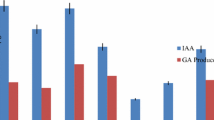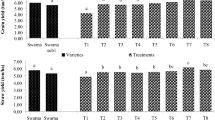Abstract
Application of plant growth promoting rhizobacteria (PGPR) affects the enhancement of growth and yield of various crops. This is due to their plant growth promoting mechanisms which could be greatly influenced by the nutritional composition of the soil. Hence, studies on the combined application of fertilizer and micronutrients with PGPR are highly significant to explore its large-scale application. In the present study, the performance of microbial consortium made from three Pseudomonas spp. was analyzed for the growth enhancement of Amaranthus tricolor (L.) in the presence of NPK fertilizer and micronutrients. After 10 weeks of treatment with Pseudomonas consortium, the plant growth parameters like shoot length, number, length and width of leaf, fresh weight, dry weight, root length and the number of root branches were analyzed along with biochemical parameters like protein and chlorophyll contents. A significant enhancement in shoot length and leaves was observed in plants which were treated with the combination of Pseudomonas consortium, 50% fertilizer and micronutrients. The result was comparable to the growth parameters observed for plants treated with 100% fertilizer. In both cases, a threefold increase in fresh weight and dry weight was observed when compared to control. Thus, the result is indicative of the applicability of the integrated system of biofertilizer and chemical fertilizer for better plant productivity. By this approach, the input of chemical fertilizer can be minimized to make the soil more productive. In an era of declining soil fertility, the method used in the study is an environment-friendly approach to improve plant productivity.







Similar content being viewed by others
References
Karlidag H, Esitken A, Turan M, Sahin F (2007) Effects of root inoculation of plant growth promoting rhizobacteria (PGPR) on yield, growth and nutrient element contents of leaves of apple. Scientia Hortic 114(1):16–20. https://doi.org/10.1016/j.scienta.2007.04.013
Suada EP, Jasim B, Jimtha CJ, Gayatri GP, Radhakrishnan EK, Remakanthan A (2015) Phytostimulatory and hardening period-reducing effects of plant-associated bacteria on micropropagated Musa acuminata cv. Grand Naine. In Vitro Cell Dev Biol Plant 51(6):682–687. https://doi.org/10.1007/s11627-015-9721-x
Gray EJ, Smith DL (2005) Intracellular and extracellular PGPR: Commonalities and distinctions in the plant–bacterium signaling processes. Soil Biol Biochem 37(3):395–412. https://doi.org/10.1016/j.soilbio.2004.08.030
Katiyar D (2016) Plant growth promoting rhizobacteria-an efficient tool for agriculture promotion. Adv Plants Agric Res 4(6):426–434. https://doi.org/10.15406/apar.2016.04.00163
Figueiredo MVB, Burity HA, Martínez CR, Chanway CP (2008) Alleviation of drought stress in the common bean (Phaseolus vulgaris L.) by co-inoculation with Paenibacillus polymyxa and Rhizobium tropici. Appl Soil Ecol 40(1):182–188. https://doi.org/10.1016/j.apsoil.2008.04.005
Ghosh R, Barman S, Mukherjee R, Mandal NC (2016) Role of phosphate solubilizing Burkholderia spp. for successful colonization and growth promotion of Lycopodium cernuum L. (Lycopodiaceae) in lateritic belt of Birbhum district of West Bengal India. Microbiol Res 183:80–91. https://doi.org/10.1016/j.micres.2015.11.011
Karthikeyan AS, Varadarajan DK, Jain A, Held MA, Carpita NC, Raghothama KG (2006) Phosphate starvation responses are mediated by sugar signaling in Arabidopsis. Planta 225(4):907–918. https://doi.org/10.1007/s00425-006-0408-8
Jaleel CA, Manivannan P, Sankar B, Kishorekumar A, Gopi R, Somasundaram R, Panneerselvam R (2007) Pseudomonas fluorescens enhances biomass yield and ajmalicine production in Catharanthus roseus under water deficit stress. Colloids Surf B 60(1):7–11. https://doi.org/10.1016/j.colsurfb.2007.05.012
George E, Kumar SN, Jacob J, Bommasani B, Lankalapalli RS, Morang P, Kumar BSD (2015) Characterization of the bioactive metabolites from a plant growth-promoting rhizobacteria and their exploitation as antimicrobial and plant growth-promoting agents. Appl Biochem Biotechnol 176(2):529–546. https://doi.org/10.1007/s12010-015-1593-3
Jimtha John C, Jishma P, Arathy GB, Anisha C, Radhakrishnan EK (2016) Identification of plant growth promoting rhizosphere Bacillus sp. WG4 antagonistic to Pythium myriotylum and its enhanced antifungal effect in association with Trichoderma. J Soil Sci Plant Nutr. https://doi.org/10.4067/s0718-95162016005000026
John Jimtha C, Radhakrishnan EK (2016) Multipotent plant probiotic rhizobacteria from Western Ghats and its effect on quantitative enhancement of medicinal natural product biosynthesis. Proc Natl Acad Sci India Sect B Biol Sci 88(2):755–768. https://doi.org/10.1007/s40011-016-0810-3
Figueiredo MVB, Seldin L, de Araujo FF, Mariano R (2010) Plant growth promoting rhizobacteria: fundamentals and applications. In: Maheshwari DK (ed) Plant growth and health promoting bacteria, vol 18. Springer, Berlin, pp 21–43. https://doi.org/10.1007/978-3-642-13612-2_2
Jimtha John C, Jishma P, Karthika NR, Nidheesh KS, Ray JG, Mathew J, Radhakrishnan EK (2017) Pseudomonas fluorescens R68 assisted enhancement in growth and fertilizer utilization of Amaranthus tricolor (L.). 3 Biotech. https://doi.org/10.1007/s13205-017-0887-2
Shukla S, Upadhyay KK, Mishra BK (2015) Genetic relationship between foliage yield and its biochemical components in vegetable Amaranth. Int J Veg Sci 22(4):322–332. https://doi.org/10.1080/19315260.2015.1042994
Alegbejo JO (2014) Nutritional value and utilization of Amaranthus (Amaranthus spp.)—a review. Bayero J Pure Appl Sci 6(1):136. https://doi.org/10.4314/bajopas.v6i1.27
Akin-Idowu P, Gbadegesin M, Orkpeh U, Ibitoye D, Odunola O (2016) Characterization of grain amaranth (Amaranthus spp.) germplasm in South West Nigeria using morphological, nutritional, and random amplified polymorphic DNA (RAPD) analysis. Resources 5(1):6. https://doi.org/10.3390/resources5010006
Basheer J, Ravi A, Mathew J, Krishnankutty RE (2018) Assessment of plant-probiotic performance of novel endophytic Bacillus sp. in talc-based formulation. Probiotics and Antimicrobial Proteins. Probiotics Antimicrob Proteins 11(1):256–263. https://doi.org/10.1007/s12602-018-9386-y
Sparks DL, Soil Science Society of A, American Society of A (1996) Methods of soil analysis. Part 3, Chemical methods. Soil Science Society of America book series. Soil Science Society of America: American Society of Agronomy, Madison
Bray RH, Kurtz LT (1945) Determination of total, organic, and available forms of phosphorus in soil. Soil Sci 59(1):39–46
Jackson MLR (1964) Soil chemical analysis. Prentice-Hall of India Pvt. Ltd., New Delhi
University KA (2011) Package of practices recommendations: crops, 14th edn. Kerala Agricultural University, Thrissur
Lowry OH, Rosebrough NJ, Farr AL, Randall RJ (1951) Protein measurement with the Folin phenol reagent. J Biol Chem 193(1):265–275
Redmile-Gordon MA, Armenise E, White RP, Hirsch PR, Goulding KWT (2013) A comparison of two colorimetric assays, based upon Lowry and Bradford techniques, to estimate total protein in soil extracts. Soil Biol Biochem 67:166–173. https://doi.org/10.1016/j.soilbio.2013.08.017
Khawas P, Das AJ, Sit N, Badwaik LS, Deka SC (2014) Nutritional composition of culinary Musa ABB at different stages of development. Am J Food Sci Technol 2(3):80–87. https://doi.org/10.12691/ajfst-2-3-1
Li Y, Sun Y, Jiang J, Liu J (2019) Spectroscopic determination of leaf chlorophyll content and color for genetic selection on Sassafras tzumu. Plant Methods. https://doi.org/10.1186/s13007-019-0458-0
Verma JP, Yadav J, Tiwari KN, Kumar A (2013) Effect of indigenous Mesorhizobium spp. and plant growth promoting rhizobacteria on yields and nutrients uptake of chickpea (Cicer arietinum L.) under sustainable agriculture. Ecol Eng 51:282–286. https://doi.org/10.1016/j.ecoleng.2012.12.022
Anuroopa N, Bagyaraj DJ (2017) Inoculation with selected microbial consortia enhanced the growth and yield of Withania somnifera under polyhouse conditions. Imperial J Interdiscip Res 3(2):127–133
Castanheira N, Dourado AC, Alves PI, Cortés-Pallero AM, Delgado-Rodríguez AI, Prazeres Â, Borges N, Sánchez C, Barreto Crespo MT, Fareleira P (2014) Annual ryegrass-associated bacteria with potential for plant growth promotion. Microbiol Res 169(9–10):768–779. https://doi.org/10.1016/j.micres.2013.12.010
Stefan M, Munteanu N, Stoleru V, Marius M (2013) Effects of inoculation with plant growth promoting rhizobacteria on photosynthesis, antioxidant status and yield of runner bean. Roman Biotechnol Lett 18:12
Molina-Romero D, Baez A, Quintero-Hernandez V, Castaneda-Lucio M, Fuentes-Ramirez LE, Bustillos-Cristales MDR, Rodriguez-Andrade O, Morales-Garcia YE, Munive A, Munoz-Rojas J (2017) Compatible bacterial mixture, tolerant to desiccation, improves maize plant growth. PLoS ONE 12(11):e0187913. https://doi.org/10.1371/journal.pone.0187913
Panwar M, Tewari R, Nayyar H (2014) Microbial consortium of plant growth-promoting rhizobacteria improves the performance of plants growing in stressed soils: an overview. In: Khan MS, Zaidi A, Musarrat J (ed) Phosphate solubilizing microorganisms: principles and application of microphos technology, pp 257–285. https://doi.org/10.1007/978-3-319-08216-5_11
Banchio E, Bogino PC, Zygadlo J, Giordano W (2008) Plant growth promoting rhizobacteria improve growth and essential oil yield in Origanum majorana L. Biochem Syst Ecol 36(10):766–771. https://doi.org/10.1016/j.bse.2008.08.006
Qessaoui R, Bouharroud R, Furze JN, El Aalaoui M, Akroud H, Amarraque A, Vaerenbergh JV, Tahzima R, Mayad EH, Chebli B (2019) Applications of new rhizobacteria Pseudomonas isolates in agroecology via fundamental processes complementing plant growth. Sci Rep. https://doi.org/10.1038/s41598-019-49216-8
Acknowledgements
The authors acknowledge Kerala State Council Science Technology and Environment (KSCSTE) for the instrumentation support. They also acknowledge Prof. (Dr.) J.G. Ray and Ms. Sayona Anna John, School of Biosciences, Mahatma Gandhi University, Kerala, India, for providing the facility for soil analysis.
Author information
Authors and Affiliations
Corresponding author
Ethics declarations
Conflict of interest
The authors declare that they have no conflict of interest to publish this manuscript.
Additional information
Publisher's Note
Springer Nature remains neutral with regard to jurisdictional claims in published maps and institutional affiliations.
Significance Statement
Talc-based formulation of Pseudomonas spp. consortium enhanced fertilizer utilization and yield of Amaranthus tricolor (L.).
Rights and permissions
About this article
Cite this article
Soumya, S., Sreejith, S., Shad, K.S. et al. Combined Effect of Pseudomonas spp. Consortium and Fertilizer with Micronutrients on Enhanced yield of Amaranthus tricolor (L.). Proc. Natl. Acad. Sci., India, Sect. B Biol. Sci. 90, 1083–1092 (2020). https://doi.org/10.1007/s40011-020-01179-x
Received:
Revised:
Accepted:
Published:
Issue Date:
DOI: https://doi.org/10.1007/s40011-020-01179-x




